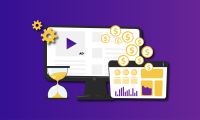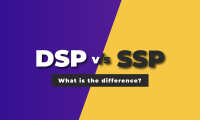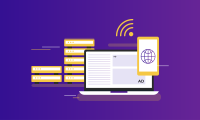Top 12 CPC/PPC Ad Networks – How To Choose The Best?
Pay-per-click (PPC) or cost-per-click (CPC) is one of the most coveted advertising models in the ad tech industry. PPC means precisely what it sounds like. Every time a user clicks on an advertisement, the publisher gets paid. This online advertising model has proven to be a promising choice amongst contemporary advertisers. Businesses using the PPC model consider it a ‘value for money’ model.
The PPC model helps advertisers gain engagement, generate relevant traffic, and deliver quantitative conversions. Given the success of the PPC advertising model, businesses are spending more and more budget for the same. On the other side of the coin, the publishers too are relishing the success of the PPC model. Over the past few years, the profits from this model shot up like bamboo. And the emergence of PPC ad networks has expedited it.
Publishers choose ad networks to maximize their yield by utilizing their ad inventories to their fullest potential. In this ever-evolving ecosystem of ad tech, the choices of PPC ad networks are diverse. It is easy to be perplexed by the overwhelming number of options. But a screening process may help the publishers narrow down the top PPC/CPC ad networks.
How can publishers choose the best PPC/CPC ad networks for their ad strategies?
When publishers are choosing their ad networks, high PPC is a crucial metric to consider. However, it is not the only metric. For holistic growth and to generate incremental revenue, publishers should look at all the below factors of a PPC/CPC ad network.
- Ad Quality
- Ad Formats
- Bidding Strategy
- Size Of The Network
- Targeting Options
Publishers can find an excellent ad network by prioritizing these factors.
Top 12 CPC/PPC ad networks for publishers
- Google AdSense
Google Adsense is one of the most popular and promising ad networks. It supports varied ad types including display ads, in-feed native ads, and in-article native ads. It also offers ad size customization to cohesively fit on the publisher’s site.
The top advantage offered by Google AdSense is free, it lets publishers monetize multiple sites through one account. Some of its disadvantages are that publishers only get paid after they have earned $100. Any policy violations or click frauds can lead to the termination of the account on the platform.
Depending on the publisher’s goals, Google Adsense supports multiple bidding strategies. In the case of CPC/PPC, this ad network offers an automated bid strategy as well as manual CPC bidding.
- Media.net
Media.net is one of the tech giants and naturally, a choice of many top companies. This ad network supports contextual ads, video ads, display to search ads, and native ads. Media.net has the same minimum payment threshold as Google Adsense. It pays its publishers on a NET 30-day basis.
One of the biggest pros of Media.net is continued collaboration with Yahoo! And Bing which offers this ad network ample ad demands. Some of its cons are that it is an invitation-based ad network and the publishers must have most of their traffic from top-tier nations.
Media.net’s programmatic implementations offer header bidding options. Publishers can also set the right bid floors and optimize keyword targeting for their inventories.
- Taboola
Taboola is a native advertising platform with over 500 million daily active users. This platform offers flexible ad creatives like videos, social media, and content advertising. According to industry standards, Taboola splits 50% of its revenue with Publishers. It has a fill rate of 100%. However, the platform has a lower CPC compared to other platforms.
One of the biggest pros of Taboola is that it uses an advanced predictive engine that delivers relevant content to its readers. Taboola has a traffic requirement of a minimum of 1 million monthly page views. Publishers can relish smart bid strategy on this platform that helps them maximize their revenue.
- Infolinks
Infolinks offers website monetization solutions to publishers on many levels. Contrary to conventional ad placement, Infolinks has unique ad placement focused on maximized relevance. It supports a variety of ad units including InFold ads, InText ads, InTag ads, and InScreen ads. However, this also accounts for one of the cons of this platform as some ad formats may seem intrusive.
Infolinks is a free advertising platform. Its minimum payment threshold comes in three levels- $50, $100, and $1000. These levels depend on the payment partner chosen by the publisher as well as their location.
It supports contextual targeting and does not have a minimum requirement of traffic for publishers. This makes it possible for small publishers to start monetizing their content with a top-notch advertising platform.
- Bidvertiser
One way for publishers to reach the premium ad demands is by partnering with Bidvertiser. This platform supports ad formats like slider ads, display ads, pop under ads, pop notification ads, in-push ads, injection pop ads, and native ads.
Bidvertiser has a minimum payout threshold of $10, $50, and $100. Publishers can earn not only through CPC but also through conversions. The payment is delivered at the end of each month.
Bidvertiser’s bid adapter shows real-time system bids to the publishers for the exact targeting of the campaigns. It also recommends a minimum bid that shows publishers how much they need to bid to get some traffic
- Facebook Audience Network
Facebook is one of the most trusted online advertising platforms. After all, it has been significant in the evolution of programmatic advertising. Facebook Audience Network is an off-Facebook, in-app advertising network for mobile apps. This is an ideal monetization platform for app owners.
Facebook Audience Network supports formats like rewarded video ads, interstitial ads, native ads, and banner ads. Audience Network has a wide customer reach. Even though the in-app ads are not shown on other Facebook properties, it still utilizes its entire customer base for targeting. This opens the publisher’s inventories to higher bidding from ample ad demands. The only drawback to consider with Audience Network is that its largest audience segment is over the age group of 30 years.
- Adcash
Adcash allows publishers of any size to monetize their websites with minimum effort across all devices. Its diverse ad formats include pop-under ads, interstitial ads, in-page push, native ads, and banner ads. Adcash has easy and flexible payment methods for its publishers. The payments are delivered regularly in 30 days and publishers can also opt for payment on demand for an amount as small as $25.
Adcash uses a CPA (cost per action) bid strategy that automatically optimizes the campaign’s traffic and performance in order to maximize the number of conversions. This CPC/PPC has some promising pros for publishers that include worldwide coverage, anti-Adblock technology, and high fill rates. However, publishers may not get very competitive CPC/PPC prices compared to some other ad networks in the market.
- RevContent
RevContent is known for its unique advertising solutions and top-notch service to help publishers monetize their websites. This ad network supports native ads, email ads, and video ads. RevContent’s real-time bidding strategy ensures increased and consistent revenue for its publishers.
One of the most promising features of RevContent is that it relies completely on first-party data. It promises the best CPM rates to its publishers in the industry and offers complete control of ads on its websites. The only of this ad network is that it has high traffic requirements and hence, is not suitable for small publishers.
- ClickAdilla
ClickAdilla is a next-generation self-service ad network. It supports over 10 ad formats including web push ads, pop-under ads, in-app ads, in-page push ads, direct links, native ads, and gallery ads. Its real-time bidding ensures the best rates for the publisher’s inventories in the span of milliseconds.
The top features of ClickAdilla are its wide range of ad formats as well as worldwide users. One of the cons that publishers should take into consideration before joining ClickAdilla is that it does not have anti-Adblock technologies.
- Publift
Publift is one of the top CPC/PPC ad networks in the ad tech industry. It severs high-quality ads without hampering the user experience of the publisher’s site. However, if needed, the ad network suggests necessary site changes to its publishers. Publift uses header bidding solutions and promises its publishers a 30%-40% increase in their revenue.
Publift may not be an ideal ad network partner for new publishers as their minimum page views requirement is 500,000 page views per month. For bigger publishers, Publift may be an ideal choice as it offers many advantages like meticulous reporting on revenue, great flexibility to run ads, and around-the-clock customer support. It does not have any lock-in contract hence publishers can leave Publift at any point if they are not satisfied with their services.
- Adblade
Adblade is one of the most innovative content-style advertising platforms. They integrate their ads seamlessly with any site design ensuring excellent user experience. Publishers can earn through clicks as well as conversions on this platform. The platform’s retargeting solutions help publishers gain more conversions.
Adblade does not have a minimum view requirement to join the platform. However, it offers various levels of services to publishers depending on their traffic. One of the cons of this platform that is offers lower CPC to the publishers compared to other CPC/PPC ad networks like Taboola.
- InMobi
InMobi is a mobile advertising platform for mobile apps and websites. It is an innovative platform that specializes in gaming monetization. It supports ad formats like immersive video ads, non-intrusive native ads, experiential playable ads, rich media ads, and dynamic carousel ads. InMobi’s customer service helps publishers and app owners decide which ad format can help them provide the best experience to their users.
InMobi uses UnifID, an innovative identity management solution to help publishers scale their addressable audiences. It also offers in-depth reporting and analysis at the impression level which makes revenue tracking easier.
Ad clicks are the KPI in understanding the effectiveness of the ad. CPC/PPC pricing model is based on the factors like ad quality and bidding which can be done both manually or programmatically. This is a leading and lucrative advertising model opted for by both advertisers and publishers. With ad personalization and contextual targeting taking over, CPC/PPC ads have become more effective and result driven.
The innovative ad tech solutions make it possible for this model to continue to thrive. By partnering with the right CPC/PPC ad network, publishers can not only amplify their yields by getting the highest bid but also experience comprehensive growth in terms of traffic and user experience.




Leave a Reply